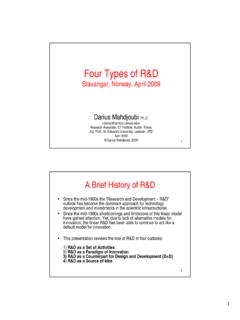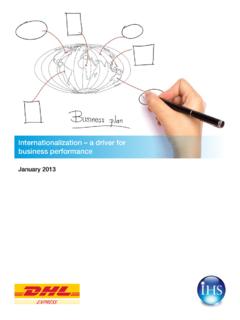Transcription of Four Types of R+D-Norway - UiS forside
1 11 four Types of R&DStavangar, Norway, April 2009 Darius Mahdjoubi, Associate, IC Institute, Austin, Texas, Adj. Prof., St. Edward s University, Lecturer, UTD April 2009 Darius Mahdjoubi, 20092A Brief History of R&D Since the mid-1960s the Research and Development R&D outlook has become the dominant approach for technology development and investments in the scientific infrastructures. Since the mid-1990s shortcomings and limitations of this linear model have gained attention. Yet, due to lack of alternative models for innovation , the linear R&D has been able to continue to act like a default model for innovation . This presentation reviews the role of R&D in four outlooks:1) R&D as a Set of Activities2) R&D as a Paradigm of innovation 3) R&D as a Counterpart for Design and Development (D+D) 4) R&D as a Source of Idea231.
2 R&D as a Set of Activities4 Research and Development R&D: A Brief ReviewThe R&D model makes a linear and one-way outlook between three consecutive stages: Basic Research, Applied Researchand Development Research. Basic Research Development Research Applied Research The Triple Helix Model for technology development (Academy, Business and Government) is also based on the R&D outlook toward as a Set of ActivitiesBasic ResearchApplied ResearchDevelopmentCommercializationR&D is a method of investigation where it is assumed new scientific knowledge is discovered due to a series of linear and sequential stages that consists of Basic Research, Applied Research and DevelopmentThe R&D model assumes that science has a monopoly over knowledge, technology is an outcome of science, and economic development is due to technology development.
3 The R&D model confines innovation to technology and then technology to R&D. 6 Examples of R&D Based Products PenicillinNuclear Power PlantsA Bomb47 R&D Spending Versus Sales and Profit The Economist, January 21-27, 2006 Money Is Not Everythingconcludes: There is no discernable relationship between R&D spending levels and nearly all measures of business success including sales, growth, gross profit, operating profit, enterprise profit, market capitalization, or total shareholder return.. No relationship exists between the number of patents issued to an organization and its business results. Money Is Not Everything. 2005. 8 Interpreting Previous Diagram Previous diagram sufficiently insightful could be interpreted in the context of more than one cluster. While the conclusion lack of discernable relationship between R&D spending levels and all measures of business may hold for the overall businesses that were studied, the diagram may actually show more than one pattern.
4 If we regroup those cases into clusters, we may find unexplored patterns. We do not need to abandon R&D, rather, we may look at in a new context!59 Growth in gross domestic product and Nobel Prize winning in physics and chemistry 102. R&D as a Paradigm of innovation 611A Paradigm Shift Around 1975?A new context for R&D appeared from another study. In my studies about innovation and entrepreneurship, and commercialization of new technologies, I noticed that around 1975, a major change happened. In the mid-1970s and later, new companies emerged such as: Microsoft, Apple, Dell, Compaq and Lotus Software. The founders of these companies did not have strong scientific background. Indeed the founders of Microsoft, Apple, CNN and Dell all were college dropouts. This was a very different pattern compared with the founders of previous successful ventures, that were dominant in the years before , 1975 Apple, 1976 Compaq, 1982 Lotus, 1982 Dell, 198312A New Outlook for innovation and Entrepreneurship This presentation looks for a new context for innovation that looks at R&D as asource of innovation , rather than the source of innovation .
5 The new outlook for innovation concentrates on the Confluence of innovation and Entrepreneurship. The unit of analysis is ventures (new businesses) that were able successfully to commercialize a new technology and become large enterprises. The following chart covers major new ventures in each time period that are consistent with the above description: 1) They were new ventures, 2) They commercialized a new technology, and 3) They were able to grow from small size and became large enterprises. 713 Polaroid,1937 Tracor, 1955 DEC,1957 Intel,1968 GE -Edison,1890 Westinghouse, 1890 Wright Brothers Airplane, 1902 Ford (Mass produced Car), 1914 Paradigms of Innovation1975200019401880 Boulton & Watt, 1775 commercialized steam Engine 1775 Microsoft, 1975 Apple, 1976 Compaq, 1982 Lotus, 1982 Dell, 1983 CNN, 1980 Industrial RevolutionLinux, 1991 E-Bay, 1995 Wikipedia, 2001 You-Tube, 2004 Face-Book, 200414 Polaroid,1937 Tracor, 1955 DEC,1957 Intel,1968 Technology & Customer T&CResearch & DevelopmentR&DSystematic InventionTrial and Error InventionGE -Edison,1890 Westinghouse, 1890 Wright Brothers Airplane, 1902 Ford (Mass produced Car)
6 , 1914 Paradigms of Innovation19752000 Linux, 1991 E-Bay, 1995 Wikipedia, 2001 You-Tube, 2004 Face-Book, 200419401880 Boulton & Watt, 1775 commercialized steam Engine 1775 User-Created Contents Microsoft, 1975 Apple, 1976 Compaq, 1982 Lotus, 1982 Dell, 1983 CNN, 1980 Industrial RevolutionManhattan Project, 1942-46815 Polaroid,1937 Tracor, 1955 DEC,1957 Intel,1968 Technology & Customer T&CResearch & DevelopmentR&DSystematic InventionTrial and Error InventionGE -Edison,1890 Westinghouse, 1890 Wright Brothers Airplane, 1902 Ford (Mass produced Car), 1914 Paradigms of Innovation19752000 Linux, 1991 E-Bay, 1995 Wikipedia, 2001 You-Tube, 2004 Face-Book, 200419401880 Boulton & Watt, 1775 commercialized steam Engine 1775 User-Created Contents Microsoft, 1975 Apple, 1976 Compaq, 1982 Lotus, 1982 Dell, 1983 CNN, 1980 Industrial Revolution Paradigms of innovation are NOT mutually exclusive!
7 During the same time span, different Types of industries may follow different paradigms of innovation . Previous paradigms may be influenced by more recent Project, 1942-4616 Five Main Paradigms of Innovation1. Trial and Error (Semi-Systematic) Invention: Represented by the steam engine. 2. Systematic invention: Represented by the light bulb and electricity. 3. Research and Development - R&D: Represented by the A-bomb, rockets and main-frame computers. 4. Technology and Market Development T&C: Represented by personal computers. 5. User-Created Contents: Represented by Linux, Wikipedia, You-Tube and Face-book. Research and Development R&D is one of the five main Paradigms of innovation , since the start of the Industrial Revolution. There are at least four other paradigms of innovation .
8 Paradigms of innovation are NOT mutually exclusive! During the same time span, different Types of industries may follow different paradigms of innovation . Previous paradigms may be influenced by more recent Future Theoretical Studies Related to Paradigms of innovation ?John Maynard Keynes was instrumental in the development of the R&D-based paradigm, but he actually did not study the R&D paradigm. 19752000194018801775 Adam Smith1723-1790 Joseph Schumpeter1883-1950 John M Keynes1883-1946????PaulRomer ?????User created contentsT& CR&DSystematic InventionTrial and Error InventionKarl Marx1818-1883 The first three of prominent economists reviewed the characteristics of the first three paradigms of innovation . Each of them, however, considered the paradigm that they studied as the default pattern of technology development.
9 It seems no major economist has elaborated yet the theoretical basis of the two recent paradigms of innovation ! Will someone do?18 Technology/Artifact Development TimelineLooking for a time-line for technology/artifact development is not new. Timeline of Inventions (copied form Smithsonian Timeline of Inventions) depicts the different time lines from 600,000 BC to 2000 and the tools that symbolize each era. This classification bundles the 1940-2000 period in one group, labeled .The above outlook at technology development covers only the hardware confines technologies. Jeffry Moor s prediction that the capacity of micro-processors increases two folds every 18 months is along this view of technology WavesEconomics of Industrial innovation (1997) by C. Freeman and L. SoeteMicroelectronicsOil, plasticsSteelCoal, ironCottonCheap Key FactorsGas/oilOil ElectricitySteam powerWater powerEnergy SystemsInformation highways, digital networksMotor highways, radio and TV, airlinesRailways (Steel), telephoneRailways (Iron)
10 TelegraphCanal, carriage roadsTransport CommunicationData networks, R&D global networks, lifetime education and trainingLarge-scale industrial and government R&D, mass higher educationIndustrial R&D labs, chemicals and electrical, national laboratories, standards laboratoriesProfessional mechanical and civil engineers, institute of technology, mass primary educationApprenticeship, learning by doing, dissenting academies, scientific societiesScience, Technology, Education, and TrainingAge of microelectronics and computer of mass production of automobiles and synthetic materialsAge of electricity and steelAge of steam power and railwaysIndustrial revolution, factory production Kondratieff WavesFifth Wave1990s ?Fourth Wave1940s 1990sThird Wave1890s 1940sSecond Wave1840s 1890sFirst Wave, 1780s - 1840,Cycle number, Approx.









